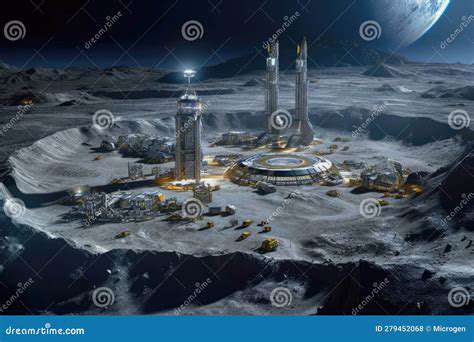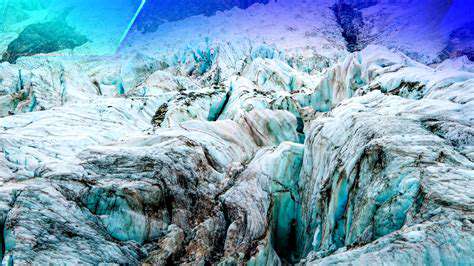Understanding Lunar Lava Tubes
These remarkable underground tunnels formed when molten lava carved passages beneath the Moon's surface. Scientists find them particularly intriguing because they offer natural protection from space radiation and meteor impacts. Studying these tubes provides clues about the Moon's volcanic past while potentially revealing evidence of geological activity. Their unique structure makes them ideal candidates for future exploration bases.
The formation process involves fascinating geology. As lava flows, its surface cools and hardens while molten rock continues moving underneath. When the eruption ends, it leaves behind hollow tunnels with interesting interior features like frozen lava flows and possible signs of ancient volcanic events.
Current Research Methods
Scientists primarily study these lunar features using data from orbiters like the Lunar Reconnaissance Orbiter. High-resolution images help identify possible tube entrances and estimate their dimensions. Combining orbital data with other observations allows researchers to spot telltale signs of subsurface tunnels.
Additional techniques include analyzing thermal patterns and studying the composition of surface materials near suspected entrances. These methods help confirm the presence and characteristics of hidden lava tubes beneath the dusty lunar surface.
The Importance of Lunar Lava Tubes for Future Missions
These natural tunnels could revolutionize lunar exploration. Their thick ceilings provide excellent protection from harmful space radiation and micrometeorite impacts, making them perfect locations for permanent bases. This natural shielding would allow longer astronaut stays while reducing health risks and equipment damage.
Furthermore, scientists suspect some tubes may contain frozen water deposits. Locating and studying these resources could prove essential for sustaining future lunar colonies and supporting deeper space exploration missions.
Exploring Potential Habitats
The stable conditions inside lava tubes contrast sharply with the Moon's extreme surface environment. Temperatures remain relatively constant underground, unlike the dramatic swings experienced on the surface. This stability would benefit both human explorers and sensitive equipment during extended missions.
While finding life seems unlikely, these tubes might preserve evidence of ancient conditions that could have supported microbial organisms. This possibility adds another compelling reason to investigate these underground spaces thoroughly.
Challenges in Exploring Lava Tubes
Investigating these subsurface features presents numerous obstacles. Simply reaching the tunnels requires overcoming significant technical hurdles. Navigating their potentially unstable interiors demands specialized robotic systems and possibly innovative human exploration techniques.
The harsh lunar environment complicates matters further. Dust contamination, extreme temperatures, and unpredictable terrain all pose serious challenges for mission planners and equipment designers working to explore these underground formations safely.
The Role of Robotics in Future Exploration
Advanced robots will lead the way in investigating these mysterious tunnels. Equipped with sophisticated sensors and imaging systems, robotic explorers can map passageways, identify hazards, and search for scientific evidence without risking human lives. Some designs might include digging mechanisms to access blocked sections.
Remotely operated vehicles prove particularly valuable for initial reconnaissance missions. Their ability to gather critical data while keeping astronauts safe makes them indispensable tools for early lava tube exploration efforts.
Potential for Lunar Resource Utilization and Future Exploration

Lunar Water Ice: A Potential Resource
Water ice discovered in permanently shadowed lunar craters could transform space exploration. This precious resource could sustain astronauts and be broken down into hydrogen and oxygen for rocket fuel. Using lunar water would drastically cut mission costs by reducing the need to transport these heavy supplies from Earth, making long-term lunar operations more feasible.
The implications extend far beyond basic survival needs. Producing rocket fuel on the Moon could serve as a stepping stone for more ambitious missions to Mars and beyond, fundamentally changing how we approach space travel.
Extracting and Processing Lunar Resources
Developing effective extraction methods remains crucial for establishing sustainable lunar operations. Researchers are testing innovative techniques like using heat to release water molecules from lunar soil, followed by purification processes to make the water usable.
Successful resource utilization requires overcoming unique challenges posed by the lunar environment. Engineers must design equipment that operates reliably in vacuum conditions while resisting damage from abrasive moon dust and extreme temperature variations.
Economic Implications of Lunar Resource Utilization
Harvesting lunar resources could spark significant economic growth, creating new space-related industries and employment opportunities. This economic potential extends beyond space agencies, potentially driving technological innovation across multiple sectors of the global economy.
A thriving lunar resource market could generate substantial revenue, encouraging greater international collaboration and investment in space exploration initiatives worldwide.
Scientific Benefits of Lunar Resource Utilization
Studying lunar materials provides invaluable insights into our solar system's formation. Analyzing the composition and age of moon rocks helps scientists reconstruct the Moon's history and understand planetary evolution. These discoveries contribute significantly to our broader understanding of cosmic origins and development.
Environmental Considerations for Lunar Resource Extraction
Responsible resource extraction must minimize environmental impact on the lunar surface. Controlling dust generation and preventing contamination preserves the Moon's scientific value for future research. Sustainable mining techniques help protect unique lunar features while allowing resource utilization.
Careful planning ensures that current activities don't compromise future exploration opportunities or damage irreplaceable geological formations.
Sustainability of Lunar Resource Utilization
Creating self-sufficient lunar operations represents the ultimate goal. This involves developing recycling systems to minimize waste and reduce dependence on Earth supplies. Establishing closed-loop life support and manufacturing systems would enable truly sustainable lunar settlements.
By implementing responsible practices now, we ensure that future generations can continue exploring and benefiting from the Moon's resources without causing irreversible damage to this celestial body.


